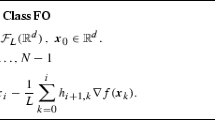Abstract
An algorithm for unconstrained minimization of a function of n variables that does not require the evaluation of partial derivatives is presented. It is a second order extension of the method of local variations and it does not require any exact one variable minimizations. This method retains the local variations property of accumulation points being stationary for a continuously differentiable function. Furthermore, because this extension makes the algorithm an approximate Newton method, its convergence is superlinear for a twice continuously differentiable strongly convex function.
Similar content being viewed by others
References
L. Armijo, “Minimization of functionals having Lipschitz continuous first partial derivatives”,Pacific Journal of Mathematics 16 (1966) 1–3.
R.P. Brent,Algorithms for minimization without derivatives (Prentice-Hall, Englewood Cliffs, N.J., 1972).
F.L. Chernous'ko, “A local variation method for the numerical solution of variational problems”,Žurnal Vyčslitel'noį Matematiki i Matematičeskoį Fiziki 5 (1965) 749–754 [in Russian; English transl.:U.S.S.R. Computational Mathematics and Mathematical Physics 5 (1965) 234–2421.
J. Cullum, “Unconstrained minimization of functions without explicit use of their derivatives”, IBM Watson Research Center, Yorktown Heights, N.Y. (1971).
J.W. Daniel,The approximate minimization of functionals (Prentice-Hall, Englewood Cliffs, N.J., 1971).
J.E. Dennis Jr. and J.J. More, “A characterization of superlinear convergence and its application to quasi-Newton methods”,Mathematics of Computation 28 (1974) 549–560.
A.V. Fiacco and G.P. McCormick, Nonlinear programming: sequential unconstrained minimization techniques (Wiley, New York, 1968).
P.E. Gill and W. Murray, “Newton-type methods for unconstrained and linearly constrained optimization”,Mathematical Programming 7 (1974) 311–350.
P.E. Gill, W. Murray and S.M. Picken, “The implementation of two modified Newton methods for unconstrained optimization”, National Physical Laboratory, DNAC Rep. 24, Teddington, England (1972).
P.E. Gill, W. Murray and R.A. Pitfield, “The implementation of two revised quasi-Newton algorithms for unconstrained optimization”, National Physical Laboratory, DNAC Rep. 11, Teddington, England (1972).
S.M. Goldfeld, R.E. Quandt and H.F. Trotter, “Maximization by quadratic hill-climbing”,Econometrica 34 (1966) 541–551.
A.A. Goldstein and J.F. Price, “An effective algorithm for minimization”,Numerische Mathematik 10 (1967) 184–189.
J. Greenstadt, “On the relative efficiencies of gradient methods”,Mathematics of Computation 21 (1967) 360–367.
J. Greenstadt, “A quasi-Newton method with no derivatives”,Mathematics of Computation 26 (1972) 145–166.
A. Matthews and D. Davies, “A comparison of modified Newton methods for unconstrained optimisation”,The Computer Journal 14 (1971) 293–294.
J.H. May, “Linearly constrained nonlinear programming: A solution method that does not require analytic derivatives”, dissertation. Yale University, New Haven, Conn. (1974).
G.P. McCormick and K. Ritter, “Methods of conjugate directions versus quasi-Newton methods”,Mathematical Programming 3 (1972) 101–116.
E. Polak,Computational methods in optimization (Academic Press, New York, 1971).
B.T. Poljak, “Existence theorems and convergence of minimizing sequences in extremum problems with restrictions”,Doklady Akademii Nauk SSSR 166 (1966) 287–290 [in Russian; English transl.:Soviet Mathematics Doklady 7 (1966) 72–75].
M.J.D. Powell, “An efficient method for finding the minimum of a function of several variables without calculating derivatives”,The Computer Journal 7 (1964) 155–162.
H.H. Rosenbrock, “An automatic method for finding the greatest or least value of a function”,The Computer Journal 3 (1960) 175.
G.W. Stewart, “A modification of Davidon's minimization method to accept difference approximations of derivatives”,Journal of the Association for Computing Machinery 14 (1967) 72–83.
D. Winfield, “Function minimization by interpolation in a data table”,Journal of the Institute of Mathematics and its Applications 12 (1973) 339–347.
W.I. Zangwill, “Minimizing a function without calculating derivatives”,The Computer Journal 10 (1967) 293–296.
Author information
Authors and Affiliations
Additional information
Research sponsored by National Science Foundation Grant GK-32710 and by the Air Force Office of Scientific Research, Air Force Systems Command, USAF, under Grant No. AFOSR-74-2695.
Rights and permissions
About this article
Cite this article
Mifflin, R. A superlinearly convergent algorithm for minimization without evaluating derivatives. Mathematical Programming 9, 100–117 (1975). https://doi.org/10.1007/BF01681333
Received:
Revised:
Issue Date:
DOI: https://doi.org/10.1007/BF01681333



